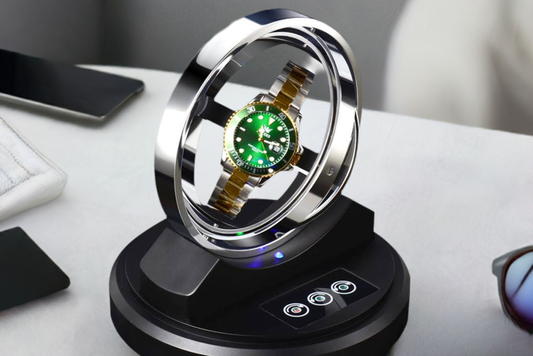Automatic watches are marvels of engineering, combining intricate mechanical movements with timeless style. However, to ensure your watch continues to run accurately and maintain its value, regular servicing is essential. In this comprehensive guide, we'll explore the factors that influence service intervals and provide expert recommendations to help you keep your automatic watch in top condition.
Understanding the Basics of Automatic Watch Maintenance
Automatic watches require regular servicing to maintain their accuracy and overall performance. The frequency of servicing depends on several factors, including usage, environmental conditions, and the watch's complexity.
Credit: YouTube Channel - Watch Repair Tutorials
General Guidelines for Service Intervals
- For watches worn regularly, service every 3-5 years
- For watches worn occasionally, service every 5-7 years
- Well-serviced watches are more accurate, reliable, and retain value better
Factors Affecting Service Intervals
-
Environmental Exposure: Watches exposed to humidity, saltwater, or extreme temperatures may require more frequent servicing every 2-3 years.
-
Usage Habits: Divers' watches and those used for water activities may need servicing every 2-3 years to maintain water resistance.
-
Watch Complexity: Watches with advanced functions like chronographs or GPS may require servicing every 3-5 years, while simpler watches can go 5-7 years between services.
The Great Debate: Annual Checks vs. As-Needed Servicing
The horology community is divided on the ideal frequency of servicing automatic watches. Let's examine both sides of the argument.
Arguments for Annual Checks
- Regular maintenance ensures optimal performance and longevity
- Annual checks allow for early issue detection and prevention
- Cleaning and lubrication reduce wear and tear, extending lifespan
- Many manufacturers recommend annual checks to maintain warranty
Arguments Against Annual Checks
- Modern watch technology has improved reliability, reducing the need for frequent servicing
- Excessive servicing can potentially introduce problems during disassembly and reassembly
- Annual checks can be expensive, especially for high-end watches
- Some watchmakers argue that servicing should only occur when necessary
The Role of Modern Watch Technology
Advances in materials science and manufacturing have led to more durable and reliable watch components, potentially extending the time between services. However, regular maintenance is still necessary for optimal performance.
Recognizing the Signs: When Your Watch Needs Servicing
Knowing when your automatic watch needs servicing is crucial for maintaining its accuracy and reliability. Here are some key indicators:
- Accuracy Decline: Consistent fast or slow running could indicate internal issues.
- Unusual Sounds: Strange ticking or whirring may point to worn or damaged components.
- Water Resistance Issues: Water seeping into the case or condensation forming inside the crystal suggests seal or gasket problems.
- Stoppage or Erratic Running: Worn parts, dirt, or mainspring issues can cause the watch to stop or run erratically.
- Cosmetic Issues: Scratches, dents, or corrosion on the case or band warrant servicing and cleaning.
The Importance of Proactive Maintenance
Regular servicing is essential for preventing damage, maintaining accuracy, extending watch life, preserving value, and ensuring water resistance. Recommended service intervals vary by manufacturer and model, typically ranging from 3-5 years.
Cost vs. Longevity: Analyzing the Value of Timely Servicing
While the cost of servicing an automatic watch can be substantial, it's important to consider the long-term benefits and value preservation.
Estimating Service Costs
- Basic service: $200 - $1,000
- Complex repairs or overhauls: $2,000 - $5,000+
- High-end brands like Rolex or Patek Philippe: $500 - $10,000+
Preserving Your Watch's Value
A well-maintained watch can retain and even appreciate in value over time, making regular servicing a worthwhile investment. For example:
- A vintage Rolex Submariner in excellent condition can sell for tens of thousands of dollars
- A pristine Patek Philippe watch can retain or increase in value
The Cost-Benefit Analysis
While the initial cost of servicing may seem high, it's a small price to pay compared to the potential long-term benefits of maintaining your watch's functionality, accuracy, and value.
DIY Maintenance and Professional Servicing
Simple at-home care routines can extend the time between professional servicing, but there are instances when expert attention is necessary.
Simple Care Routines for Automatic Watches
- Cleanliness: Regularly wipe your watch with a soft cloth to remove dirt and oils.
- Magnetic Field Protection: Keep your watch away from strong magnetic fields to avoid accuracy issues.
- Water Resistance: Check gaskets and seals regularly for wear and replace if needed.
- Battery Replacement: For quartz movements, replace the battery every 12-24 months.
- Storage: Store your watch in a cool, dry place away from direct sunlight when not in use.
When to Seek Professional Help
Professional servicing is necessary when you encounter:
- Accuracy Issues: If your watch runs fast or slow by more than a few minutes per day.
- Water Damage: Signs of fogging or rust require immediate attention.
- Physical Damage: A cracked crystal or bent hands need professional repair.
- Maintenance Intervals: Most manufacturers recommend servicing every 3-5 years.
What to Expect During Professional Servicing
- Disassembly: The watch is taken apart, and each component is inspected.
- Cleaning and Lubrication: Components are cleaned and lubricated for smooth operation.
- Replacement of Worn Parts: Genuine or equivalent components replace worn or damaged parts.
- Reassembly and Testing: The watch is reassembled and tested for accuracy and functionality.
- Water Resistance Testing: Water-resistant watches are tested to ensure proper gasket and seal function.
Diver's Watch Maintenance: Special Considerations
Diver's watches require extra attention due to exposure to water, pressure, and salt. Key maintenance aspects include:
- Water Resistance Testing: Regular testing ensures seals and gaskets remain intact.
- Cleaning and Lubrication: Thorough cleaning and lubrication prevent corrosion and wear.
- Gasket Replacement: Gaskets and seals should be replaced every 2-3 years or as recommended by the manufacturer.
- Pressure Testing: Diver's watches should undergo pressure testing to simulate deep diving conditions.
Recommended servicing intervals for popular diver's watches:
- Omega Seamaster Planet Ocean: Every 3-5 years
- Rolex Submariner: Every 2-3 years
- Breitling Superocean: Every 4-5 years
- Panerai Luminor Submersible: Every 3-5 years
Debunking Common Misconceptions
Can an Automatic Watch Last a Century Without Service?
While some watches can run for extended periods without service, neglecting regular maintenance is not advisable. Most manufacturers recommend servicing every 3-5 years to ensure accuracy and functionality.
The Myth of Oil Drying Up and Modern Lubricants
Modern lubricants used in watchmaking are designed to last longer and perform better. While lubricants can evaporate over time, this process occurs gradually, and regular servicing helps maintain optimal performance.
Key Signs Your Watch Needs Servicing
- Timekeeping Issues: Gaining or losing time beyond the manufacturer's tolerance (typically 4-6 seconds per day for certified chronometers)
- Condensation Under the Crystal: Moisture inside the crystal can cause corrosion and damage to the movement
- Unusual Noises: Rattling or strange sounds from the watch case can indicate loose parts or other issues
- Malfunctioning Complications: Incorrectly functioning features like chronographs or date displays may signal the need for servicing
Conclusion: Crafting Your Watch's Service Strategy
Regular servicing is crucial for maintaining the accuracy, reliability, and value of your automatic watch. By understanding the factors that influence service intervals, recognizing the signs of needed maintenance, and following expert recommendations, you can develop a tailored service plan that keeps your timepiece running smoothly for years to come.
To ensure your watch receives the best care, seek out a reputable watchmaker with experience in your specific brand and model. By investing in timely servicing, you not only preserve your watch's performance but also maintain its legacy as a cherished and valuable possession.
Do you have any experiences or tips to share about maintaining your automatic watch? Let us know in the comments below, and feel free to share this article with fellow watch enthusiasts who may find it helpful!




